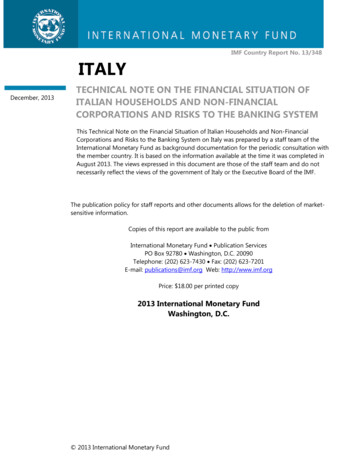
Transcription
IMF Country Report No. 13/348ITALYDecember, 2013TECHNICAL NOTE ON THE FINANCIAL SITUATION OFITALIAN HOUSEHOLDS AND NON-FINANCIALCORPORATIONS AND RISKS TO THE BANKING SYSTEMThis Technical Note on the Financial Situation of Italian Households and Non-FinancialCorporations and Risks to the Banking System on Italy was prepared by a staff team of theInternational Monetary Fund as background documentation for the periodic consultation withthe member country. It is based on the information available at the time it was completed inAugust 2013. The views expressed in this document are those of the staff team and do notnecessarily reflect the views of the government of Italy or the Executive Board of the IMF.The publication policy for staff reports and other documents allows for the deletion of marketsensitive information.Copies of this report are available to the public fromInternational Monetary Fund Publication ServicesPO Box 92780 Washington, D.C. 20090Telephone: (202) 623-7430 Fax: (202) 623-7201E-mail: publications@imf.org Web: http://www.imf.orgPrice: 18.00 per printed copy2013 International Monetary FundWashington, D.C. 2013 International Monetary Fund
ITALYFINANCIAL SECTOR ASSESSMENT PROGRAMAugust 2013TECHNICAL NOTETHE FINANCIAL SITUATION OF ITALIAN HOUSEHOLDSAND NON-FINANCIAL CORPORATIONS AND RISKS TO THEBANKING SYSTEMPrepared ByMonetary and Capital MarketsDepartmentThis Technical Note was prepared by IMF staff in thecontext of the Financial Sector Assessment Programin Country. It contains technical analysis and detailedinformation underpinning the FSAP’s findings andrecommendations. Further information on the FSAPcan be found at:http://www.imf.org/external/np/fsap/fssa.aspx.
ITALYCONTENTSINTRODUCTION AND MAIN FINDINGS 4THE ITALIAN HOUSEHOLD SECTOR 5A. Household Balance Sheets 5B. The Housing Market 9C. Financial Linkages 11D. Sensitivity Analysis 16THE ITALIAN NON-FINANCIAL SECTOR 22A. Non-Financial Corporate Balance Sheets 22B. Financial Linkages 24C. Insolvency and Debt Restructuring 29D. Sensitivity Analysis 32E. Contingent Claims Analysis 36CONCLUDING REMARKS 39REFERENCES 40TABLES1. Household Debt Burden (2010) 172. Sensitivity Analysis of Indebted Households 203. Firms’ Ratio of Interest Expense to Gross Operating Income 334. Ratio of Interest Expense to Gross Operating Profits by Firm Size (2011) 345. Ratio of Interest Expense to Gross Operating Profits by Firm Size (2011) 35FIGURES1. Household Debt and Wealth 82. The Housing Market 103. Households’ Financial Conditions 144. Italian Household: Baseline Debt Vulnerability 185. Italian Household: Sensitivity Analysis 216. Corporate Leverage, Funding Sources, and Profitability 257. Firms’ Financial Conditions 288. The Financial Situation of Italian Firms 349. Sensitivity Analysis for Italian Firms 3610. Contingent Claim Analysis for the Corporate Sector 38BOXES1. Support Measures for Low-Income and Distressed Households 152INTERNATIONAL MONETARY FUND
ITALY2. Measures to Support SME Financing 273. The Legal Debt Restructuring Framework for Firms 31INTERNATIONAL MONETARY FUND3
ITALYINTRODUCTION AND MAIN FINDINGS11.This paper analyzes the vulnerabilities of the balance sheets of the Italian householdand corporate sector in order to assess the risk to the banking system. It takes a differentapproach than the solvency and liquidity stress tests by assessing the financial soundness of themain borrowers of the Italian banking system—households and the non-financial corporate sector—and quantifying the potential impact from macroeconomic shocks. It relies on various sources ofinformation, including aggregate statistics and more granular information from household surveysand corporate balance sheet databases.2.The credit risk from Italian households is mitigated by their considerable net wealth.Income has declined during the crisis, leading to tighter financial conditions for households,especially for young and low-income groups, but low indebtedness, high levels of assets anddeclining interest rates have protected households from wide-spread debt payment difficulties.Sensitivity analysis show that further deterioration in economic conditions, through a fall in incomeand higher interest rates, would reduce households’ debt repayment capacity, but their net wealthposition would continue to provide a considerable buffer, thereby dampening the potential riskfrom the household sector to the banking system.3.Real estate is the predominant source of collateral for loans, and severe strains in thehousing market could increase bank losses. The sharp drop in housing market activity reflects theeconomic downturn, which has in turn put downward pressure on prices. Though housing prices arenot estimated to be substantially misaligned, continued weak activity is likely to put furtherdownward pressure on prices in the next few years. Sensitivity analysis shows that a moderatedecline in housing prices could be absorbed, partly due to the prudent loan-to-value ratios appliedto loans, but a more extreme shock, though not anticipated, would likely trigger credit losses forbanks and eat into provisioning coverage.4.The financial situation of non-financial corporations, in particular SMEs, is fragile, asevidenced by already high loan default rates. Even if the indebtedness of Italian firms ismoderate, leverage is high and has increased. About one-third of Italian firms, holding 45 percent ofthe debt, are estimated to have interest payment coverage at vulnerable levels. SMEs have higherthan average leverage and lower interest payment coverage. Downside shocks to profits and interest1Prepared by Bergljot Bjørnson Barkbu. The note incorporates the following important contributions: Paolo FinaldiRusso and Antonio de Socio (Bank of Italy) provided the sensitivity analysis for Italian firms, Dawn Chew (LegalDepartment) drafted Box 3 on corporate bankruptcy law and parts of section III.C, and David Velazquez Romero(European Department) carried out the Contingent Claims Analysis. I would also like to thank Marcello Bofondi, LauraBartiloro, Silvia Magri, Raffaella Pico and Francesco Zollino at the Bank of Italy for excellent input and suggestions,and Zhengpeng Guo, Chen Kan, Piyaporn Nikki Sodsriwiboon, Amadou Sy, and Kenichi Ueda for very helpfulcomments and advice.4INTERNATIONAL MONETARY FUND
ITALYrates would increase credit risk stemming from the corporate sector though the additional strainswould likely be contained.5.Continued strong policy action will be important to mitigate the impact of thesevulnerabilities, especially for firms. The government’s new initiative to pay part of its overduedebt represents a crucial step to ease firms’ liquidity constraints. Continued efforts to increaseprovisions including by reducing fiscal disincentives and speed up the judicial process, strengthenprudential considerations in collateral valuation and disclosure, and strengthened capital plans,where needed, will be crucial to bolster confidence in banks, given the increase in non-performingloans on their balance sheets. Also, further development of the private market for distressed assetswould help accelerate the disposal of non-performing loans and promote corporate restructuring.Finally, with SMEs relying heavily on bank financing and suffering from tight credit conditions,measures to expand SME financing, through more risk-based bank lending and opening up nonbank financing channels, will be crucial to support their financial situation and the economicrecovery.THE ITALIAN HOUSEHOLD SECTORA. Household Balance Sheets6.Italian households’ debt level is low in an international perspective. Debt ratios morethan doubled during the low-interest period following the launch of the euro area; and have gonefrom 33 percent of gross disposable income in 1998 to 74 percent December 2012 (Figure 1).2However, they remain well below those in other large economies such as France, Germany and theUnited Kingdom, as well as the euro area average of 109 percent. Mortgages have been the keysource of the increase in household debt to banks (from a share of 50 percent of total bank loansin 2003 to 60 percent in 2012), though reliance on mortgage financing continues to be lowcompared to other countries.607.The small degree of aggregateindebtedness reflects a modest share ofindebted households. About 25 percent ofhouseholds had debt outstanding, comparedwith 40 to 50 percent in other major euro areacountries, and more than 60 percent in theUnited States and the United Kingdom. Thehighest proportion of indebted households isamong those with higher income, with41 percent of those in the highest quintilehaving outstanding debt (see Bank of2Proportion of Households with DebtIn uro areaItalySource: ECB (2013).Households include households and non-profit institutions servicing households.INTERNATIONAL MONETARY FUND5
ITALYItaly, 2012a). Among lower-income households (lowest quintile), only 17 percent have debtoutstanding. The median debt-to-income ratio for Italian indebted households is about 50 percent,10 percentage points below the euro area average. Among indebted household, the average debtto-income ratio was 112 percent in 2010, though it is much higher for the lower-income households.Also, given the high frequency of low values and progressively declining frequency for higher values,the median debt-to-income ratio is much lower, at 46 percent. Debt-service, however, remainsmoderate, at an average of 13 percent of income for indebted households in 2010, in line with theeuro area average.8.The ratio of debt to disposable income has continued to increase during the crisis,mainly due to stagnating income. The pace of growth of household debt slowed during the crisis,reflecting tight credit conditions and low demand. Due to modest wage growth and highunemployment, household disposable income has declined somewhat during 2008–12, and hasfallen by 13 percent in real terms (Figure 1). As a result, households’ debt-to-income burden hascontinued to increase and the household savings rate dropped from 13 to 8 percent over the sameperiod as many lower-income households became unable to save (see Bartiloro andRampazzi, 2012).9.Italian households have considerable wealth, as well as a buffer of liquid assets.In 2010, Italian households’ net wealth and their ratio of liquid assets to income were above theeuro area average, while the debt-to-asset ratio was below. Net wealth represented about 8 timesdisposable income, somewhat lower than in the U.K. (8¼), but higher than in France (7¾) and Japan(5½). In the three years 2008–10, total net wealth increased by 1¾ percent; the growth was theresult of the flow of saving, which, though declining, more than offset the effects of the lossescaused by the fall in the value of financial assets.25030Net Wealth and Debt-to-AssetsMedian Net wealth (euros)20025Debt-to-assets (in percent, rhs) 1/201502525Net Liquid Assets to IncomeIn o areaGermanySource: ECB (2013).1/ For indebted households.5500GermanyItalyEuro areaFranceSpainSource: ECB (2013).10.Real assets, mostly housing, represent an important share of Italian households’wealth. Home ownership in Italy is high, with 68 percent of households owning their house in 2010,which is high compared to the euro area average (60 percent), Germany (44 percent) and France(58 percent), though below Spain (83 percent). Real assets make up about two thirds of household6INTERNATIONAL MONETARY FUND
ITALYassets, and given relatively stable housing prices to date, have protected households fromfluctuations in asset prices during the financial crisis (see Bank of Italy, 2012b).11.Financial wealth is concentrated in less risky assets such as deposits and bonds. Thevalue of Italian households’ financial assets as a ratio to disposable income (3½) has remainedbroadly unchanged during the crisis. Some 92 percent of Italians hold financial assets, somewhatbelow the euro area average (97 percent). The proportion of Italian households holding riskier assetssuch as mutual funds (6 percent) and shares (5 percent) are about half that of the euro area average(11 and 10 percent, respectively). Italian households’ financial portfolios contain a high proportion ofrelatively low-risk assets, partly reflecting an ageing population, such as public and private bonds(15 percent, compared to a 5 percent euro area average), and insurance and pension reserves. Overthe past decades, mostly due to a decline in asset prices, the value of investment in risky assets hasdeclined. Consequently, the share in financial assets of mutual funds and shares has been reducedfrom 47 percent in 2000 to 25 percent in 2012. Ownership of the riskier assets is concentrated inhigh-income households, with holders of mutual funds and shares predominantly belonging to thetwo highest quintiles of the income distribution.12.Low-income and young households have a small and declining share of the wealth,making them more vulnerable to an economic downturn. Low-income and young householdshave been more strongly hit by the decline in income and tight financial conditions during the crisis.The richest 10 percent of households owned 46 percent of net wealth in 2010, up from 44 percentin 2008. The net wealth of low-income households is 7 percent, which is low in a historicalperspective, and young households (with a head younger than 35 years) also hold a historically lowshare of net wealth, at 5 percent.INTERNATIONAL MONETARY FUND7
ITALYFigure 1. Italy: Household Debt and WealthHousehold debt in Italy is low in an internationalperspectiveMortgage financing has expanded, but remains belowlevels in other advanced countries200200Household Debt to Gross Disposable Income, 1998-2012 1/180(In lyFranceEuro 0Consumer credit10010080806060404020200ItalyFranceGermany Euro areaSpainUKSource: ECB, Eurostat.The economic downturn has reduced real disposableincome and savings50Debt-to-income (mean)Debt-to-income (median)Households with debt (rhs)Household Disposable Income and Savings Rate(In percent and index 2007 100)100301002050101090002ndSource: Bank of Italy.3rd4th5thTotalQuintilesHousehold Net Wealth(in percent of disposable income)10008008006006004004002002000-200Savings rate (rhs)80199920012003200520075200920112013The share of riskier assets in financial assets has beenreduced, mostly reflecting declining asset values100Household Financial Assets(In percent of total)10080806060404020200LiabilitiesFinancial assetsReal assetsNet wealth-4000-200-4001998Source: Bank of Italy.8Real disposable incomeSource: ISTAT.High real assets have contributed to a comfortable andstable net wealth position100015401501st120Mortgage60Debt-to-Income Ratio and Indebted Households(In percent, 2010)20012000Debt is less frequent among lower-income households,though their average debt burden is more elevated250140Household Debt to Banks to Gross Disposable Income,2003, 2007 and 2012Other(In percent)2012Source: Eurostat, ISTAT and other national statistics agencies.1/ Household includes households and non-profit institutions serving households3001402008INTERNATIONAL MONETARY FUND201102000Shares and mutual fundsSource: Bank of Italy.2007Bonds2012ReservesDeposits
ITALYB. The Housing Market13.House price inflation in Italy has been in line with the euro area average. Over the lastdecade, Italian housing prices increased on average by 4½ percent a year, about 2 percentagepoints above HICP inflation, consistent with euro area trends (Figure 2). Indices of affordability showthat Italian house prices are somewhat above their long-term average, calculated as the averagesince 1980, though less so than in countries where housing prices appear substantially overvalued.The price-to-rent ratio was 2 percent above its historical average in 2012, while the price-to-incomeratio was 15 percent above. However, a study by the Bank of Italy—based on an econometricanalysis to determine a simultaneous equilibrium on the property market, the mortgage market andthe construction loan market—suggests that housing price developments have been in line withfundamentals over the 25 years estimation period.3 The current discrepancy between actual andequilibrium housing prices is estimated to be less than one percentage point.14.The weak economy and credit tightening have nevertheless translated into sharpdeclines in housing market activity over the past year. High unemployment and declining realincomes coupled with tightened bank lending standards have led to sharp falls in constructioninvestment and depressed house sales to half the peak level recorded in 2006. Housing transactionsstarted falling sharply in early 2012. Transactions declined by an annual rate of 30 percent in 2012Q4, (Figure 2), though recovered to -14 percent in 2013 Q1, and the annual growth rate ofhousehold mortgages turned negative in the beginning of 2013. The average time to sale hasreached more than 8 months. The majority of responding real estate agents in the April 2013Housing Market Survey (Bank of Italy, 2013a) believes that the real estate tax put into effect in 2012have contributed to weak activity and price declines.15.Weak housing market activity and confidence have in turn exerted downward pressureon prices. The Housing Market Survey shows that the number of transactions is being depressed bya large price gap between sellers and buyers. The discount-to-ask price for sold houses reached16 percent in 2013 Q1 (Figure 2). The official house price indices from ISTAT and the Bank of Italyshow that housing prices have fallen by almost 7 percent since their peak in 2011. The price fall islarger for existing houses than new houses, for which prices just started falling in 2012 Q3. Priceindices from private sources show a larger price decrease, but have less comprehensive coverageand do not capture the quality adjustment embedded in the official price index. In the next fewyears, continued weak activity and tight lending conditions are likely to put further downwardpressure on prices. In this vein, most real estate agents surveyed by the Bank of Italy expect prices tocontinue to fall in the next two years.3See Nobili and Zollino (2012).INTERNATIONAL MONETARY FUND9
ITALYFigure 2. Italy: The Housing MarketHouse prices in Italy have increased broadly in line withthe euro area average260Housing Prices(Index, 2000 100)240ItalyFranceGermanySpainEuro areaUK220200180160House prices relative to income are somewhat above longterm averages, but less so than in some 010080802000200220042006200820102012Italy: House Transactions and Real House Price(Index, 2000 100)United 1999200120032005200720092011The discrepancy of official price indices with privatesources reflects quality adjustment and a larger sample300House Price Indices(Index, 1990 100)250100100Transactions80Real price60602012Real estate agents expect prices to continue to decline inthe short urce: Agenzia del Territorio, Bank of Italy, and ISTAT.140Ireland13030012080150ItalySource: OECD.Transactions have fallen by almost 50 percent since theirpeak in 2006, but the price adjustment has been limited140160(Index, long-term average 100)United States1997Source: ECB, Halifax and Nationwide Building Society.170House Price-to-Income RatiosExpected Housing Prices Change 1/-10Bank of 82011Source: Bank of Italy/ISTAT and Nomisma.A large price gap between sellers’ and buyers’ prices is oneof the reasons for an increasing average time to sale189Price Discount and Sale Time16Time to sale (rhs, months)-208Discount-to-ask price 09201020112012Source: Bank of Italy.1/ Balance of real estate agents' opinion indicating increase ordecrease in prices in the current quarter.10INTERNATIONAL MONETARY FUND8620082009Source: Bank of Italy.201020112012
ITALYC. Financial Linkages16.Bank credit to households has tightened since the onset of the crisis. Prior to the crisis,during 2005–07, household debt granted by banks grew at an annual pace of more than 10 percent.The growth slowed rapidly to 3 percent during 2008–09 and turned negative in late 2012, reaching-1 percent in May 2013. The deceleration in 2012 affected all categories of loans, though mortgageswere particularly impacted, as new mortgages granted in 2012 roughly halved compared to 2011.4New consumer loans fell somewhat less, by 14 percent. The Bank Lending Survey (Bank ofItaly, 2013b) shows that both tighter credit standards by banks and lower loan demand byhouseholds have contributed to the decline in credit. Currently, lower loan demand appears to bethe predominant factor, with households being affected by weak consumer confidence, lowerconsumption and negative housing market prospects. Banks’ tight credit standards are explained bynegative prospects of the economy and the housing market for mortgages, and increasing concernsabout the credit worthiness of households for consumer credit.17.Households’ relatively strong balance sheets have mitigated the impact of the crisis onbanks’ asset quality.5 The stock of bad debt was 6 percent of total household debt in June 2013, ofwhich about 65 percent is secured with real assets (Figure 3). Default rates, given by the ratio of newbad loans to total performing loans at the beginning of the period, have been stable at 1¼ percentover 2010–13, relative to about ¾ percent in the pre-crisis years. But more leading indicators suchas past due and doubtful loans have recently seen increases, pointing to a possible furtherdeterioration in household credit quality. Past due household loans increased to 1.2 percent in June2013, compared to 0.9 percent in December 2011, and doubtful household loans increased to2.6 percent from 2.1 percent over the same period.6 For both past due and doubtful loans, theincreases have been mainly for consumer credit and other loans (comprising overdrafts andmortgages other than those used to purchase primary residences).18.Loan-to-value (LTV) ratios for mortgages are prudent, and have decreased for newmortgages. The low LTV ratios are, in part, a result of strict housing credit regulations and prudentbank practices. According to the Housing Market Survey, LTV ratios on new mortgages have declinedfrom 69 percent at end-2008 to 56 percent in early 2013 (Figure 3). The average length of newmortgage loans has remained broadly constant at 22 years over this period. For outstandingmortgages, about two thirds had LTV ratios of between 50 to 80 percent, and only 8 percent hadLTV ratios above 80 percent in September 2012. The LTV ratios for first-time home buyers in Italy areat the lower range of those in euro area countries. The Bank of Italy estimates that the share ofmortgages in negative equity is near zero.4The reduction in new mortgages is partly due to a drop in mortgage substitution and subrogation, as interest rateson new mortgages became less favorable.5The loan classification rules and supervisory practices are more conservative in Italy than elsewhere in Europe,making comparison of NPL figures across countries potentially misleading.6The increase in past due loans is partly explained by the expiration of exceptions that allowed banks to wait toclassify loans as past due until they had been in arrears for 180 days. Now that the exceptions have expired, loansthat have been in arrears for 90 days are classified as past due.INTERNATIONAL MONETARY FUND11
ITALY19.Default rates on mortgages are low, more so for younger vintages. Stricter selectioncriteria and lower LTV ratios for mortgage loans have translated into a pronounced decline indefault rates on mortgage loans concluded during 2009–11, compared to those granted in the threeprevious years.20.A low share of mortgages and variable interest rates limit further the balance sheetrisk for banks. Outstanding mortgage lending amounted to EUR 365 billion at end-December 2012,accounting for some 15 percent of total bank credit. Most mortgages––about 70 percent––havevariable rates typically linked to the three-month Euribor, though of these, 10 percent have a cap onthe interest rate. The reduction in Euribor rates following the 2008 financial crisis reduced the debtburden of indebted households. However, as part of the tightened credit conditions, lenders haveincreased the spread over Euribor on new mortgages, to about 3½ percentage points, against anaverage of 1 percent in the pre-crisis years.10090Typical Loan-to-Value for a First-TimeHome 06200520040.520090.520100.0Yr disb.Source: Bank of Italy.1.58020112.0New Mortgage Loans in Default,by Year of Disbursement(in percent of number of contracts)2011 1 yr 2 yrs 3 yrs 4 yrs 5 yrs 6 yrs 7 yrs0.0 8 yrsSource: Bank of Italy.21.Mortgage substitution and subrogation are commonly used to enhance the financingterms. A 2007 reform liberalized the mortgage market, including through the elimination of prepayment penalties, effectively increasing the mobility of mortgage customers. Mortgagesubstitution, where a borrower renegotiates the contract (with the same bank or a new bank) toobtain better financing conditions, possibly also amending the amount of the loan, or mortgagesubrogation, where borrower ends the contract and start a new contract (with the same or anotherbank) to obtain better financing conditions, have been common in past years when interest rateswere low and falling. However, with worsening financing terms on new mortgages in 2011–12,mortgage substitutions and subrogations are now less attractive. Mortgage substitutions andsubrogations amounted to about 12 percent of new mortgages in 2011, down from 20 percentin 2009 and 16 percent in 2010, and are expected to have decreased further in 2012. Renegotiationswith the same banks were done for 7½ percent of mortgages in 2008, 3 percent in 2009 and1–2 percent in 2010–11. The number of debt restructurings, where the bank incurs a loss, is verylimited (less than 0.1 percent of loans in December 2012).22.Banks and the government have adopted measures to protect low-income anddistressed borrowers during the crisis. Under the initiative of the Italian Banking Association andthe main consumer organizations, a moratorium on mortgages was implemented in February 2010,with wide participation from banks (Box 1). The moratorium expired in March 2013, and has enabled12INTERNATIONAL MONETARY FUND
ITALYaround 100,000 homeowners to suspend repayments. Since banks do not incur a loss, mortgageunder the moratorium are not classified as “restructured” and are not considered part of impairedloans. About 70 percent of those benefiting from the moratorium have resumed regular paymentsat the end of the suspension, suggesting that the measure has improved the creditworthiness of theparticipating households (see Bartiloro, Carpinelli, Finaldi Russo and Pastorelli, 2012, and Bank ofItaly, 2012c). The government’s Solidarity Fund (Box 1) is targeted at low-income households andcontributes to interest payments on mortgage loans for first-time home buyers during paymentsuspensions. The capital endowment of EUR 20 million for 2011 was quickly exhausted, andcontributed to the interest payments of 5,000 households. A further EUR 20 million have beenallocated for 2012–2013.23.Mortgage loans are full recourse under Italian law, offering considerable protection tocreditors. As in other countries in continental Europe, borrowers in Italy must repay their debt infull, regardless of any change in the value of the property, and a creditor can in some cases attachother (present and future) assets of the debtor.24.The recent law on personal bankruptcy provides support for house
This Technical Note on the Financial Situation of Italian Households and Non-Financial . Monetary and Capital Markets Department This Technical Note was prepared by IMF staff in the context of the Financial Sector Assessment Program in Country. It contains technical analysis and detailed information underpinning the FSAP's findings and


![The GIANO-TNG spectrometer [6269-46]](/img/1/spie-6269-46.jpg)







